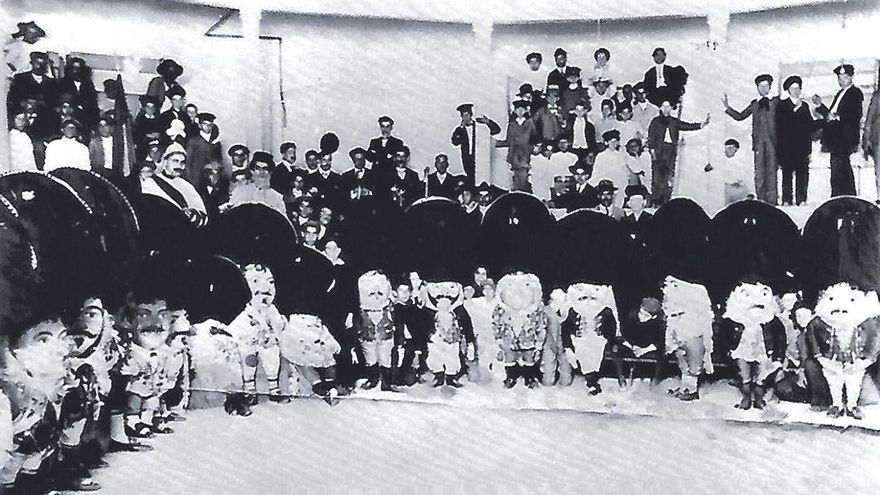
In the year 1892, as the date approached commemorating the fourth centenary of the founding of the Very Noble, Loyal, Invincible and Very Beneficent City of Santa Cruz de Santiago de Tenerife, at that time the capital of the province of Canarias, the mayor of Santa Cruz, Anselmo de Miranda y Vazquez, wanted to exalt the Cross of Conquest by giving its festivity an institutional character.
“All the religious and popular events that took place during the first week of May were very solemn, being the best celebrations that had been held up to that time.”
One of the scheduled events was the Dwarf Dance, proposed by Benigno Ramos Hernández, a native of Los Llanos de Aridane, established in Santa Cruz de Tenerife since 1885, where he owned the hotel El Telégrafo and a grocery store, in the building located in Plaza de la Constitución, corner of Calle San Francisco, and a confectionery on Calle Cruz Verde. He also engaged in contracting, money exchange, commission sales, and consignment of goods with agents in Cadiz and Cuba. Years later, he would open a catering business on Calle San Francisco, a furniture store and carpentry on Calle San Juan Bautista, and an import company on Calle Candelaria.
This character, with a reputable name in Santa Cruz society, would collaborate in the May Festivals of 1892, adapting the Dwarf Dance that has accompanied the Virgin of the Snows every five years since 1676, from its Sanctuary to Santa Cruz de La Palma, to the stage of the Municipal Theatre (Guimerá) in Santa Cruz de Tenerife.
The dancers, belonging to the La Palma colony residing in Tenerife, began their rehearsals in March, and the premiere took place on May 2, 1892, with a packed Municipal Theatre eager to admire one of the most famous traditions of the island of La Palma.
The masks used were the ones premiered at the Lustral Festivals of La Palma in 1890, created by Aurelio Carmona López.
The show consisted of an entrance choir, the arrival of the mascot with its entourage of dwarfs to the tune of a polka written by Francisco Martín Rodríguez, a member of the Royal Academy of Fine Arts of the Canaries, and ended with the singing of verses written by Juan Padrón Rodríguez, performed by the orchestra and choir of the Philharmonic Society of Santa Cecilia, directed by Juan Padrón himself.
To give the spectacle a theatrical character, the staging posed multiple challenges to fit the so-called Giant Dwarf and the 12 pairs of dwarfs, with their costumes, onto the stage. Nevertheless, these 25 figures performed their prodigious choreography, causing continuous hilarity among the audience due to the grotesque nature of their movements and, above all, the expressions on their faces.
The overwhelming success of the performance led the organizer to offer two additional performances the following Saturday and Sunday; one to benefit the Hospital of Dolores in Santa Cruz de La Palma, and the other to raise funds for the new headquarters that the Mutual Aid and Free Education Society La Benéfica was building on Calle Ruiz de Padrón, of which Benigno Ramos was a board member.
When they were presented again at the Municipal Theatre the following weekend, the attendance was so huge that many spectators had to sit in the aisles on chairs they had brought from their homes.
Every evening, after finishing their performance at the Theatre, the members would repeat it in Constitution Square, packed with the public, although the musical part was performed with guitars and mandolins by the members of the Philharmonic Society of Santa Cecilia.
The following month, the Dwarf Dance would be presented in La Orotava, during the celebrations of San Isidro Labrador and the Octave of Corpus, before travelling to Las Palmas de Gran Canaria. Towards the end of the summer, Benigno Ramos would take the Dwarf Dance to the theatre of Santa Clara, in Cuba.
The Dwarf Dance would be performed again at the May Festivals of 1894; in these, the astute industrialist from La Palma had the idea of depicting the images of politicians of the time, including Sagasta and Martínez Campos, on the masks of the dwarfs; the former with a kind smile and the latter with seriousness and frankness.
The success of the show was once again resounding, with full houses at the various functions held at the Municipal Theatre and in the Bullring. The tour would also return to La Orotava, Cadiz, and Cuba.
From 1905 onwards, Miguel Salazar Pestana would devise a new stage setting, dressing the dwarf as a man of that era, covered with a bicorne hat, and incorporating a booth where the illogical, incomprehensible, and always enigmatic transformation of tall men into Lilliputians takes place.















